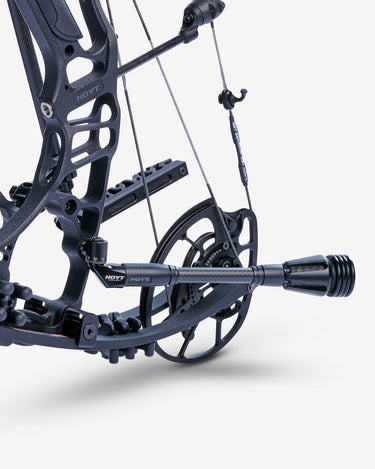Optimize Your Archery Accuracy With These Bow Stabilizer Techniques
One critical component that can dramatically affect your efficiency is the correct application of bow stabilizers. Whether you are a skilled archer looking to refine your skills or a newcomer eager to enhance your precision, understanding these bow stabilizer techniques might be the trick to striking your mark with unparalleled uniformity.
Benefits of Making Use Of Bow Stabilizers
Making use of bow stabilizers can considerably improve an archer's accuracy and overall efficiency by decreasing bow torque and vibration. Furthermore, bow stabilizers dampen resonance, which not only enhances the convenience of capturing however additionally stops the bow from jumping upon launch, hence helping in keeping appropriate aim.
Moreover, bow stabilizers can assist in holding the bow consistent, especially throughout gusty conditions or when firing from longer ranges. The added weight at the front of the bow offers stability and equilibrium, permitting the archer to concentrate on aiming without the interruption of bow activity. In general, the advantages of using bow stabilizers extend beyond simply precision, boosting the archer's experience and performance in various shooting scenarios.
Picking the Right Bow Stabilizer
Selecting the suitable bow stabilizer is important for maximizing your archery devices and boosting shooting performance. When choosing a bow stabilizer, there are several aspects to think about to ensure you find the best suitable for your demands. First of all, consider the weight of the stabilizer. Much heavier stabilizers can help in reducing bow torque and absorb more resonance, leading to a steadier goal. Nevertheless, lighter stabilizers use even more maneuverability, which can be beneficial in specific shooting situations.

Lastly, think about the layout of the stabilizer. Some stabilizers feature flexible weights or dampeners that permit you to customize the equilibrium and feeling of your bow. Ultimately, selecting the right bow stabilizer involves finding an equilibrium in between weight, style, product, and size to enhance your shooting precision and overall efficiency.
Correct Installation Strategies
To ensure optimum efficiency and safety in archery, grasping correct installment methods for your bow stabilizer is necessary. The very first step in installing a bow stabilizer is to determine the proper placement on your bow.
Following, securely attach the stabilizer to the bow using the suitable placing equipment. Some stabilizers come with adjustable weights that can be added or gotten rid of to make improvements the equilibrium of your bow.

Adjusting Stabilizer Weight and Length
After guaranteeing the proper setup of your bow stabilizer, the following step involves readjusting the weight and length to enhance its efficiency in boosting archery accuracy. The weight of the stabilizer plays an essential duty in minimizing bow movement during the shot cycle. Including weight to the stabilizer can aid moisten resonances and enhance security, causing even more constant and accurate shots. On the various other hand, minimizing the weight can increase ability to move, which is advantageous for scenarios calling for fast target acquisition.
When it comes to stabilizer size, finding the right equilibrium is vital. A longer stabilizer can give better stability by enhancing the range in between the bow and the weight at the end of the stabilizer. This added range improves the stabilizing effect, specifically in windy problems or when firing at longer distances. On the other hand, a much shorter stabilizer provides more ability to move and may be liked by archers that value agility and quick activities during shooting.
Advanced Stabilizer Tuning Tips
Attaining optimum bow stability and accuracy in archery demands a nuanced strategy to sophisticated stabilizer adjusting. Advanced stabilizer tuning entails fine-tuning various parts to improve the bow's equilibrium, reduce resonance, and improve total precision. One crucial strategy is to experiment with various stabilizer configurations, consisting of side-bar and back-bar arrangements, to locate the optimal balance between stability look at this site and maneuverability for your shooting design. bow stabilizer. Furthermore, readjusting the angle and positioning of the stabilizer can have a significant influence on how the bow reacts upon launch.
One more important aspect of innovative stabilizer adjusting is maximizing the damping residential or commercial properties of the stabilizer system. This can be attained by integrating additional moistening find out accessories such as rubber dampeners or harmonic stabilizers to even more decrease vibration and noise. Exploring different products for the stabilizer building, such as carbon fiber or aluminum, can likewise influence the bow's performance by changing its weight circulation and rigidity. By carefully tweak these innovative stabilizer aspects, archers can maximize their precision and uniformity on the range or in competition.
Final Thought
In conclusion, taking full advantage of archery accuracy can be attained via the proper option, setup, and adjustment of bow stabilizers. On the whole, integrating bow stabilizers right into archery practice can lead to improved efficiency and enhanced precision.
Utilizing bow stabilizers can considerably improve an archer's precision and general efficiency by reducing bow torque and vibration. Longer stabilizers give greater stability and balance, especially for long-distance shooting, while much shorter stabilizers supply even more convenience and are much easier to steer in limited areas (bow stabilizer). Carbon fiber stabilizers are light-weight and sturdy, while light weight aluminum stabilizers are robust and supply outstanding vibration wetting
A longer stabilizer can supply greater security by increasing the range in between the bow and the weight at the end of the stabilizer.An additional crucial aspect of sophisticated stabilizer adjusting is maximizing the damping residential or commercial properties of the stabilizer system.